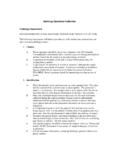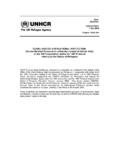Transcription of CHAPTER 7 Self-directed violence
1 CHAPTER 7 Self-directed violenceBackgroundIn the year 2000 an estimated 815 000 people diedfrom suicide around the world. This represents anannual global mortality rate of about per100 000 population or one death about every40 seconds. Suicide is the thirteenth leading causeof death worldwide (see Statistical annex). Amongthose aged 15 44 years, self-inflicted injuries arethe fourth leading cause of death and the sixthleading cause of ill-health and disability (1).Deaths from suicide are only a part of this veryserious problem. In addition to those who die, manymore people survive attempts to take their own livesor harm themselves, often seriously enough torequire medical attention (2).
2 Furthermore, everyperson who kills himself or herself leaves behindmany others family and friends whose lives areprofoundly affected emotionally, socially and eco-nomically. The economic costs associated with self-inflicted death or injuries are estimated to be in thebillions of US dollars a year (3).How is suicide defined?Suicidal behaviour ranges in degree from merelythinking about ending one s life, through devel-oping a plan to commit suicide and obtaining themeans to do so, attempting to kill oneself, to finallycarrying out the act ( completed suicide ).The term suicide in itself evokes directreference to violence and aggressiveness.
3 Appar-ently, Sir Thomas Browne was the first to coin theword suicide in hisReligio medici(1642). Aphysician and a philosopher, Browne based theword on the Latinsui(of oneself) andcaedere(tokill). The new term reflected a desire to distinguishbetween the homicide of oneself and the killing ofanother (4).A well-known definition of suicide is the onethat appears in the 1973 edition of the Encyclo-paedia Britannica, quoted by Shneidman: thehuman act of self-inflicting one s own life cessa-tion (5). Certainly in any definition of suicide, theintention to die is a key element. However, it isoften extremely difficult to reconstruct the thoughtsof people who commit suicide unless they havemade clear statements before their death about theirintentions or left a suicide note.
4 Not all those whosurvive a suicidal act intended to live, nor are allsuicidal deaths planned. To make a correlationbetween intent and outcome can therefore beproblematic. In many legal systems, a death iscertified as suicide if the circumstances areconsistent with suicide and if murder, accidentaldeath and natural causes can all be ruled has been much disagreement about themost suitable terminology to describe suicidalbehaviour. Recently, the outcome-based term fatalsuicidal behaviour has been proposed for suicidalacts that result in death and similarly non-fatalsuicidal behaviour for suicidal actions that do notresult in death (6).
5 Such actions are also often called attempted suicide (a term common in the UnitedStates of America), parasuicide and deliberateself-harm (terms which are common in Europe).The term suicidal ideation is often used in thetechnical literature, and refers to thoughts of killingoneself, in varying degrees of intensity andelaboration. In the literature, the term also refersto a feeling of being tired of life, a belief that life isnot worth living, and a desire not to wake fromsleep (7, 8). Although these different feelings orideations express different degrees of severity,there is not necessarily a continuum between , the intention to die is not a necessarycriterion for non-fatal suicidal common form of Self-directed violenceis self- mutilation .
6 This is the direct and deliberatedestruction or alteration of parts of the bodywithout conscious suicidal intention. Favazza (9)has proposed three main categories:.Major self- mutilation including self-blind-ing and the amputation of fingers, hands,arms, limbs, feet or self- mutilation such as bangingone s head, biting oneself, hitting one s arm,gouging one s eyes or throat, or pulling one self- mutilation suchas cutting, scratching or burning one s skin,sticking needles into one s skin, or pullingone s hair 7. Self-directed involves verydifferent factors from suicidalbehaviour and will not be dis-cussed here further. For an ex-tensive review of self- mutilation ,see Favazza (9).
7 The extent of theproblemFatal suicidal behaviourNational suicide rates vary con-siderably (see Table ). Amongcountries reporting suicide to theWorld Health Organization, thehighest suicide rates are found inEastern European countries (forexample, Belarus per100 000, Estonia per100 000, Lithuania per100 000 and the Russian Federa-tion per 100 000). Highrates of suicide have also beenreported in Sri Lanka (37 per100 000 in 1996), based on datafrom the WHO Regional Officefor South-East Asia (10). Lowrates are found mainly in LatinAmerica (notably Colombia 100 000 and Paraguay per100 000) and some countries inAsia (for example, the per 100 000 and Thailand 100 000).
8 Countries in otherparts of Europe, in North Amer-ica, and parts of Asia and thePacific tend to fall somewhere inbetween these extremes (for ex-ample, Australia per100 000, Belgium per100 000, Canada per100 000, Finland per100 000, France per100 000, Germany per100 000, Japan per100 000, Switzerland per100 000 and the United StatesTABLE suicide rates by country, most recent year availableaCountry or areaYear Total number Suicide rate per 100000 populationof suicides TotalMale Female Male:female b bAustralia19982 b bBelarus19993 and Herzegovina Kong rural andurban areas1999 16 Republic19991 10 11 23 b (excludingCanal Zone) REPORT ON violence AND per 100 000).
9 Unfortunately, little in-formation is available on suicide from countriesin Africa (11).Twocountries,FinlandandSweden,haved ataonsuicide rates dating from the 18th century and bothshow a trend for increasing suicide rates over time(12). During the 20th century, Finland, Ireland, theNetherlands, Norway, Scotland, Spain and Swedenexperienced a significant increase in suicides, whileEngland and Wales (combined data), Italy, NewZealand and Switzerland experienced a significantdecrease. There was no significant change inAustralia (12). During the period 1960 1990, atleast 28 countries or territories had rising suiciderates, including Bulgaria, China (Province ofTaiwan), Costa Rica, Mauritius and Singapore,while eight had declining rates, including Australia,and England and Wales (combined data) (12).
10 Rates of suicide are not distrib-uted equally throughout the gen-eral population. One importantdemographicmarkerofsuicideriski s age. Globally, suicide rates tendto increase with age, althoughsome countries such as Canadahave also recently seen a secondarypeak in young people aged 15 24years. Figure shows the globalrates recorded by age and sex in1995. The rates ranged from 100 000 in the group aged 5 14 years to per 100 000among people aged 75 years andolder. In general, suicide ratesamong those aged 75 years andolder are approximately threetimes higher than those of youngpeople aged 15 24 years. Thistrend is found for both sexes, butis more marked among men.















